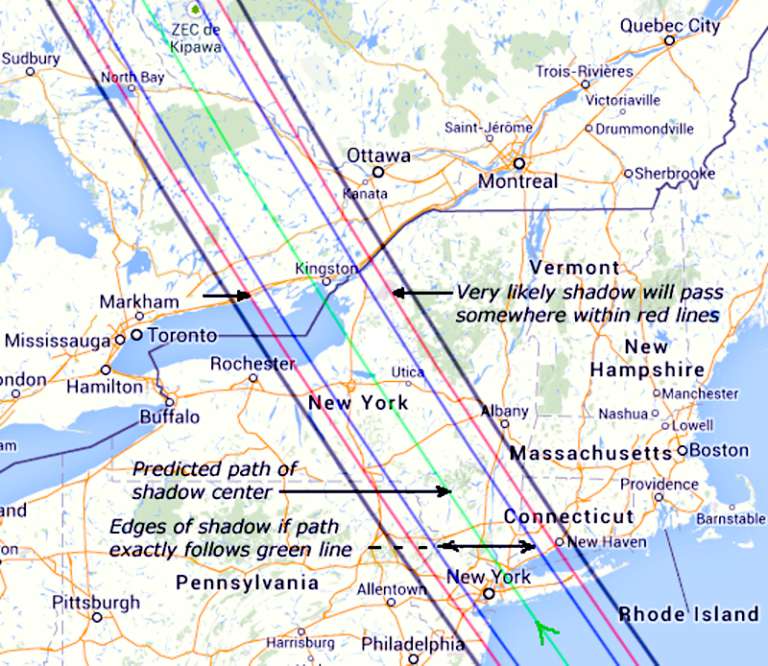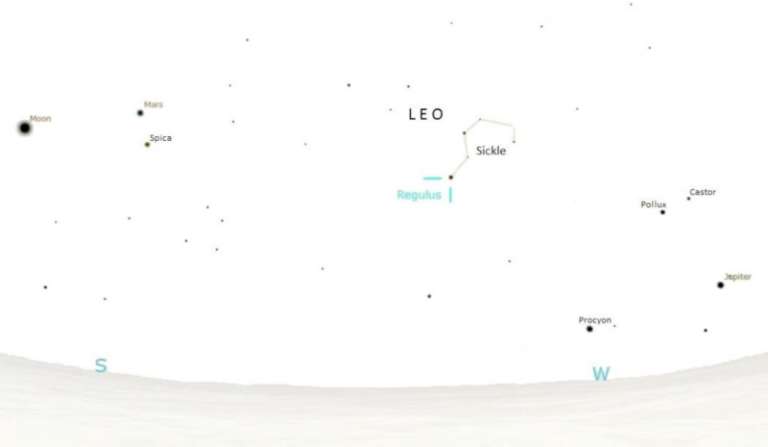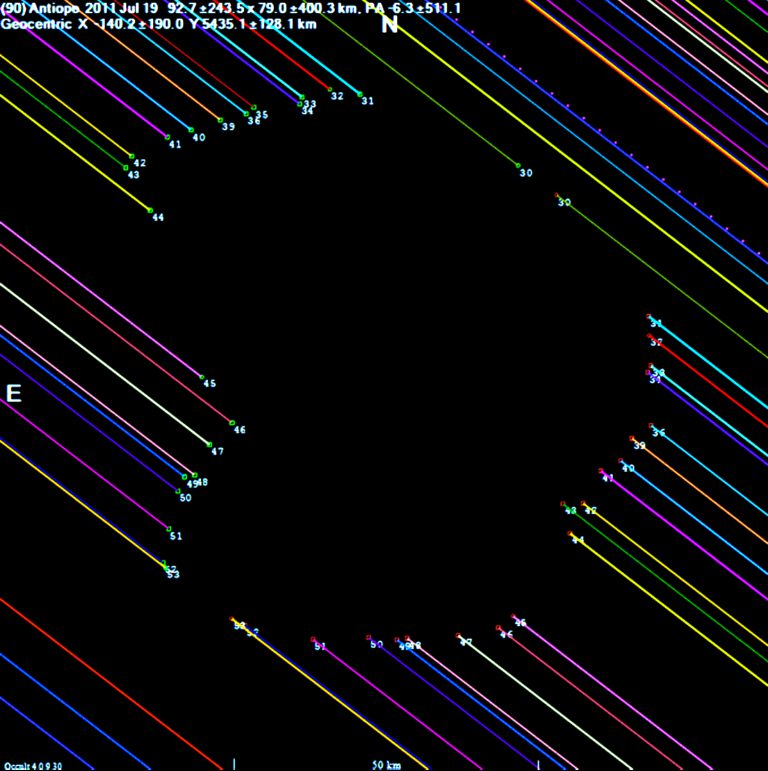Ted Blank • Mar 03, 2014
Eyes and stopwatch are all that are needed to help measure an invisible asteroid
Would you like to be part of one of the largest citizen-science efforts in the history of astronomy? The International Occultation Timing Association (IOTA) invites you to join in the campaign to observe and time the best and brightest asteroid occultation ever predicted to occur over a populated area – and no telescope is required!
Just after 2:06 am on Thursday EDT, March 20th, the bright star Regulus (Alpha Leonis, magnitude 1.3) in the constellation Leo will disappear for up to 14 seconds for more than 20 million people in the New York Metropolitan area and parts of New Jersey, Connecticut, upstate New York, Ontario and Quebec as the asteroid (163) Erigone passes in front of it. The image below shows the predicted path of the shadow of the asteroid over the ground.

The following image shows the times when the shadow is predicted to arrive at various locations along the path. A zoomable interactive map showing the exact path prediction with error bars can be found here.

As exciting as this event will be to observe, this is more than just an invitation to share in a moment of celestial drama. IOTA wants you to actually go out and time this rare, naked-eye occultation yourself and submit your timing data through a dedicated reporting website. In this way you will be contributing to the study of the asteroid responsible for Regulus' disappearing act. You can become a true citizen-scientist with little more than your eyes and a stopwatch or video camera – part of a “picket fence” of observers stretching across the entire shadow path and beyond.
A full set of Frequently Asked Questions (with answers) about how to observe and time the event can be found on the IOTA website here, but in this posting I will try to offer a summary of the opportunity and answer some of the more common questions. You may also refer to the article in the April, 2014 issue of Sky & Telescope, pp. 30-32 for additional information. Remember, the event happens early Thursday morning so set your alarm when you go to bed on Wednesday night, March 19th (or just stay up late).
How can I be certain the star I’m looking at is Regulus?
As long as the weather cooperates (and if it doesn’t, you are encouraged to travel to somewhere along the path with clear skies), finding Regulus will be easy. It will be in the Southwest about 40 degrees above the horizon. Here’s a trick - on that night at any time after about 1:30 am, just face directly at the Moon and stretch both arms out to your sides. Now turn your head to the right and sight along your right arm; Regulus will be directly over your right hand, about halfway up to a point straight overhead. In darker skies it will appear at the bottom of the "sickle of Leo" which takes the shape of a backward question mark, tilted on this night slightly to the right. The sky maps below (the dark one matching what you will see in the sky, and the light one a printer-friendly version to save ink) show Regulus and some of the other celestial objects which will be in the same area of the sky on that night to help you get oriented. Additional skymaps customized for different levels of light pollution can be found here.


Will I see the asteroid?
No, the asteroid itself will be much too small and dark to see, but that won’t matter. Even though we can’t see it, the occultation measurements will be like giving the asteroid a CAT scan from 177 million km away!
What will we learn from the data?
Timing an occultation turns out to be a surprisingly effective way to measure the shape and size of an asteroid, and it’s a whole lot cheaper than sending a spacecraft up to take photos. Each measurement of the occultation’s duration (the amount of time the star is not visible) measures one diameter or chord across the body of the asteroid. With many timings from multiple observers spread across the shadow path it is possible to reconstruct the asteroid's entire irregular silhouette, as shown below (for an occultation by a different asteroid that took place in 2011). Additionally, these measurements provide a level of resolution that far exceeds anything that can be achieved with Earth-bound telescopes – down to +/- 1 km, or better than one part in one hundred million. Also, Regulus itself spins so fast that it is more oblate than round. Lucky observers near the edge of the path may see a slower, “grazing” occultation which will help scientists understand the exact size and shape of the star.

How should I time the event?
There are numerous techniques by which you can easily measure the duration of the occultation. Most experienced IOTA observers now record asteroid occultations with a low-light video camera and a GPS-based time inserter. However, Regulus is so bright that you can use a regular digital SLR (DSLR) with a zoom lens to record the occultation into a video file. If you choose this technique you should select the highest ISO, the maximum zoom, the widest aperture and a rate of 30 frames per second at 1/30th second exposure. Record continuously from two minutes before to two minutes after the predicted time for your location using a zoom lens of 150mm or longer focal length. (The more you zoom in, the brighter Regulus will appear.) Careful manual focusing will be required, and it will probably be best to first focus on Jupiter and then swing the camera over to Regulus without changing focus. Your video can then be submitted to IOTA for analysis where we will count the frames in which the star is not visible. (Detailed instructions for DSLR recording and submitting your video can be found here. To be certain your video will be useful, follow the instructions on that website to send in a test video in advance.)
Another way would be to use a stopwatch or a stopwatch app on your smartphone. There are also accurate “timing” smartphone apps that will let you tap the screen to record the exact times of the disappearance (D) and reappearance (R) of the star (for example, Timestamp by Emerald-Sequoia for iPhones, or TimeTheSat for Android phones). These apps have the advantage that they synchronize themselves to timeservers on the web, so in addition to a duration measurement your D and R times can be reported in Univeral Time (UTC). (Note: these apps do not reset your smartphone time, which may be off UTC by many seconds, but that won’t matter if you report the app timestamps.)
Before smartphones and video cameras became ubiquitous, many occultation observers used an audio recorder to record shouts of "out" and "in" while a shortwave radio tuned to WWV provided an audible time signal in the background. This is a highly effective way to time the occultation as well. You can then extract the elapsed time (and the D and R times) from the audio file by opening it later in a free audio editing tool like Audacity. If you don’t have a shortwave radio, several apps like Emerald Time and Atomic Clock have an option where they will “tick” audibly every second. They also sync themselves to UTC as long as they can get a cellphone or wireless signal. Just play one of these apps close to the microphone while you observe and record your audio. If you don’t use WWV, then read the actual time from the app into the microphone once before and once after the event for a few seconds so you will know what time the time-ticks actually correspond to.
Of course if you don’t have any of this equipment you can also just watch the star and start counting “one cig-a-rette, two cig-a-rette” when you see it disappear to get an estimate of the duration. Any timing is better than no timing at all, and since each syllable of the phrase represents a quarter of a second just remember what syllable you were on when the star re-appeared, then report your measured duration and location through the web site. (Practice this in advance by watching a clock that displays seconds so you will learn to count at the correct rate.)
Do I need to make a report if I don’t see the star disappear from my location?
Yes! If you watch or record Regulus the entire time and the star does not disappear at all, you should definitely report this as well. It means that due to the uncertainty in the path prediction the shadow of the asteroid passed slightly to the east or west of you. Reporting this event (called a "miss") is extremely important, because the closest "miss" to someone else’s positive observation provides a very strong constraint on the location of the edge of the asteroid. Our “picket fence” of observers will be as wide as possible but we don’t know exactly what path the shadow will follow. Therefore all "misses" should be reported. Your “miss” report could be the one that matters most!
What if I live really far from the path and cannot travel?
It is possible that the asteroid may have one or more moonlets or satellites. Typically these orbit the parent body within about 10 diameters. A tiny “blink” of the star from a satellite might be visible anywhere from Kentucky eastward to Nova Scotia. The odds are low, but if you have video capability just record Regulus for a few extra minutes on either side of the occultation time (say, from 5 minutes before to 5 minutes after) and submit your video for analysis. You may end up discovering a new moon of Erigone! (It will help to observe in pairs so that a second confirmation recording is available. This will avoid the uncertainty that a tiny blink might be a bird or bat momentarily covering the star.) It will help if you record time-ticks on the audio track of the video and record a few seconds of a timing app on the video after you start and before you stop recording.
How do I report my results?
A dedicated public reporting website has been developed here where you can easily submit your timings (or equally importantly tell us that you observed a “miss”). It is also very important that you tell exactly where you were standing. However, there is no need to write down your GPS coordinates at your observing location. Just remember where you were, and the reporting website will allow you to zoom in on a Google map until you see the exact spot where you were located. Double-clicking on that spot will tell us exactly where you were, after which you can enter your duration or times. The site is in test mode now but will be made active about a week before the event.
For any questions you might have that are not answered at the FAQ page, a dedicated email address has been set up at [email protected]. Last minute weather predictions will be posted to the event’s Facebook page. If you are able to travel safely to areas where there is a higher likelihood of clear skies, we encourage you to do that. IOTA members are available to help you in any way we can and we wish you the best of luck with your observations.
How can I learn more about IOTA?
The International Occultation Timing Association gathers measurements on about 200 asteroids per year, and welcomes all interested parties, both amateur and professional, to join and participate. Asteroid occultations, Lunar occultations and Lunar grazes are all part of IOTA’s goal of encouraging the scientific study of asteroids and stars through occultation timing. For example, every year new double stars whose components are too close to be resolved optically are discovered through occultations. More information about IOTA’s mission and activities can be found at www.occultations.org.
Links referenced above:
Facebook page for last minute weather updates and information
DSLR recording documentation and instructions
Zoomable, interactive map showing predicted path of the shadow with error estimates
Let’s Go Beyond The Horizon
Every success in space exploration is the result of the community of space enthusiasts, like you, who believe it is important. You can help usher in the next great era of space exploration with your gift today.
Donate Today

 Explore Worlds
Explore Worlds Find Life
Find Life Defend Earth
Defend Earth

